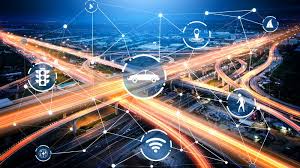
Smart Infrastructure: When Roads and Bridges Think for Themselves
Imagine a world where highways warn drivers about icy patches before they slip. Bridges detect cracks and call for repairs before they collapse. City streets redirect traffic in real-time to avoid congestion.
This isn’t the future. It’s already happening—thanks to smart infrastructure.
From embedded sensors to AI-powered maintenance systems, the world’s roads, bridges, and transit systems are beginning to think for themselves. The result? Safer travel, smoother traffic, and cities that fix themselves before things go wrong.
🧠 What Is Smart Infrastructure?
Smart infrastructure combines physical structures (like roads, bridges, tunnels) with digital intelligence—sensors, data analytics, connectivity, and automation—to monitor, adapt, and even self-correct.
Key components include:
-
IoT sensors to detect stress, vibration, moisture, or cracks
-
AI algorithms that predict wear and tear
-
5G connectivity for real-time communication
-
Automation for dynamic responses (e.g., changing speed limits, rerouting traffic)
Think of it as giving infrastructure a nervous system and a brain.
🚧 Smart Roads: More Than Just Pavement
🛣️ Embedded Sensors
Roads in places like the Netherlands and South Korea are embedded with sensors that track traffic flow, surface temperature, and vehicle weight. This data helps:
-
Alert drivers to black ice or flooding
-
Trigger automatic de-icing systems
-
Improve citywide traffic patterns
⚡ Solar-Powered Roads
Some smart roads double as solar panels, generating clean energy while supporting electric vehicle charging lanes or even lighting themselves at night.
🧠 AI-Controlled Traffic
In cities like Pittsburgh and Barcelona, AI manages intersections and reroutes traffic based on real-time congestion data, reducing commute times and carbon emissions.
🌉 Smart Bridges: Safety Without Guesswork
🔍 Structural Health Monitoring
Traditional bridge inspections rely on scheduled checks—often months or years apart. Smart bridges use sensors that continuously monitor stress, corrosion, and movement.
If a crack begins to form or a joint loosens, the system can:
-
Send alerts to engineers
-
Predict failure risk
-
Schedule proactive maintenance
Bridges like the Golden Gate and the Queensferry Crossing in Scotland already use these technologies to enhance safety.
🌆 Smart Cities, Smarter Futures
Smart infrastructure is a backbone of the smart city vision. By integrating buildings, roads, transit, and utilities into a connected ecosystem, cities can:
-
Reduce traffic congestion
-
Cut emissions
-
Improve emergency response times
-
Lower maintenance costs through early detection
For example, Singapore’s intelligent transport system uses a network of smart cameras and sensors to manage traffic in real time, reducing accidents and delays.
⚠️ Challenges on the Road Ahead
Despite its potential, smart infrastructure still faces roadblocks:
-
High upfront costs for sensors and installation
-
Cybersecurity risks—what if hackers target a smart highway?
-
Data privacy concerns about vehicle and location tracking
-
Maintenance of the tech itself, which can fail or become outdated
Governments and engineers must build secure, scalable systems—and make sure human oversight remains in the loop.
🌍 A Global Movement
Countries are investing billions in upgrading infrastructure:
-
United States: The Bipartisan Infrastructure Law includes funding for smart roads and bridges.
-
China: Building a network of smart highways for autonomous vehicles.
-
Germany & Japan: Investing in sensor-based rail systems for safety and efficiency.
Even developing nations are exploring smart solutions for more resilient, future-proof infrastructure.
🧠 Final Thought
Smart infrastructure is turning passive concrete and steel into active, intelligent systems. Roads that warn. Bridges that heal. Cities that adapt.
As this technology evolves, it promises not just convenience—but life-saving innovation.
Soon, our infrastructure won’t just support us—it will watch over us.